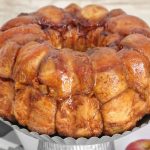Utah’s Lion House restaurant is known for its Lion House rolls, a regional speciality. These rolls, like the Parker House roll, are soft and rich in butter. However, they have a signature spiral that breaks into layers of feathery bread. These rolls make the perfect pillow to soak up soups and sauces.
What are Lion House Rolls?
These rolls are made from an enriched dough, which means that in addition to flour and water, the dough is also enriched with fat, egg, and dairy.
Simple Cauliflower Rice Recipe
We use dry milk powder for these rolls. This is what we found in nearly all of the Lion House roll recipes. The dough is brushed with milk powder (or powdered milk) and then brushed with butter.
The addition of fats such as butter or eggs to the dough helps prevent gluten formation. This works well for pizza and sourdough, but we prefer soft, fluffy rolls.
What if I don’t have milk powder?
Although milk powder is a common ingredient for Lion House rolls, you can substitute both the water and the milk powder with 1 1/2 cups whole milk. It worked well in my test batch.
How do you know if your yeast is alive or dead?
It is so disappointing when you bake a recipe and find that your rolls don’t rise or your yeast has gone bad.
Inadvertently killing yeast can happen to new bakers when they add it to too hot milk or water. The liquid should be between 80degF and 100degF. You should be able to use a thermometer if you don’t have one. Keep the liquid at room temperature, but cool enough that your fingers can comfortably rest in it before adding yeast.
You should see yeast dissolve in the liquid mixture. A few dried granules are fine. The yeast should foam up and then float on top of the milk mixture after about five minutes. If the yeast looks dry and has not frightened, it’s probably dead.
How to Make Lion House Rolls in No Time
Bake Lion House rolls as soon as possible. These are best after they have been out of the oven for around 20 minutes.
To get ahead of the rest, you can make the dough the night before and freeze it.
- These roles require a slow rise. The dough can be made the night prior and kept in the fridge for a slow initial rise. This will make the butter in the dough firmer and will make it super smooth and easy to roll out. You can also use a room temperature rise if you have a short time, but the chilled dough is easier to work with. Bake them the next day and then serve.
- For frozen lion house rolls, please Go through the shaping stage and freeze them on a sheet pan. After they are completely frozen, could you place them in a freezer bag? They should last for at least one month in the freezer.
- Bake from frozen rolls: Spread the rolls out on a baking tray according to the recipe. Cover with plastic and let the rolls cool in a warm area (in an oven with only the light on) until they double in size. This could take several hours, depending on the temperature outside. Bake the bread according to the instructions.
How to double this recipe
Make more rolls than the recipe calls for. However, this would be very difficult for even a large-capacity mixer at home, so I don’t recommend it.
Lion House Rolls
PREP TIME60 minutes
COOK TIME20 minutes
TOTAL TIME 80 minutes
SERVINGS12 rolls
This dough is best made in the evening. Then, it should rest overnight in the fridge. You can substitute the water and powder with 1/2 cup of whole milk if you don’t have milk powder.
Ingredients
- 1 1/2 cups lukewarm.
- 1/2 cup (50g), dry milk powder
- 3 tablespoons granulated sugar, divided
- 1 teaspoon (8g) active yeast
- 1/4 cup unsalted butter, melted and cooled
- 1 large egg
- 5 cups (610g) all-purpose flour
- 1 1/2 teaspoons kosher Salt
- To complete the rolls:
- 1/4 cup unsalted butter, melted, cool, and then divided
- Flaky Salt to sprinkle (optional).
Method
- Get ready to prepare your bowl.
- Lightly oil a large bowl. Once the dough is ready, you will be adding your dough.
- The yeast is blooming:
- Combine the milk powder, water, yeast, one tablespoon sugar, and the bowl of a stand mixer. Use a spatula to mix the mixture briefly. Allow it to foam for about five minutes.
- Get the dough:
- When the yeast is foamy, add 2 tablespoons of sugar, 1/4 cup butter, egg, flour, and Salt.
- Use the dough hook to attach the mixer to the bowl. Mix on medium-low speed until dough forms. Then, turn up the mixer to medium speed and continue kneading for 6 minutes.
- Make a well in the bowl. Knead the dough a few times on the counter before you form a ball.
- First rise:
- Cover the dough ball with the oil and then cover it with plastic. The dough should be placed in a bowl and allowed to rise for at least one hour.
- Make sure to roll the dough.
- Roll out the dough in a long, oblong shape about two hours before baking. It should measure approximately 40×10 inches and be about 1/8 inch thick.
- Butter the dough, roll it, and then divide it:
- Spread 1/3 of the melted butter on the dough. Leave a 1-inch border at the end closest to you.
- The buttered dough should be rolled from the longest side, just like a long cinnamon roll. Cut the log in half by pinching the seam. Each log should measure approximately 20 inches.
- Divide each log into six equal parts.
- Second rise
- Place the buns seam-side down on a sheet pan, four to a row. To prevent the dough from sticking to the pan, dust the tops with flour and then cover the buns with plastic. Allow the rolls to rise in a warm place until they are doubled, approximately 1 hour. If you wish to freeze the rolls, you can do so after you have divided them but before the second rise.
- Bake the Rolls
- Turn the oven on to 350°F. Bake the risen rolls for 20 minutes in the middle of the oven. Turn the pan halfway through to ensure even browning.
- Let cool the rolls and then butter them.
- Take the rolls out of the oven and let them cool on a rack. Brush the warm rolls with the remaining butter. Salt can be added if desired. Allow cooling to room temperature before serving.



